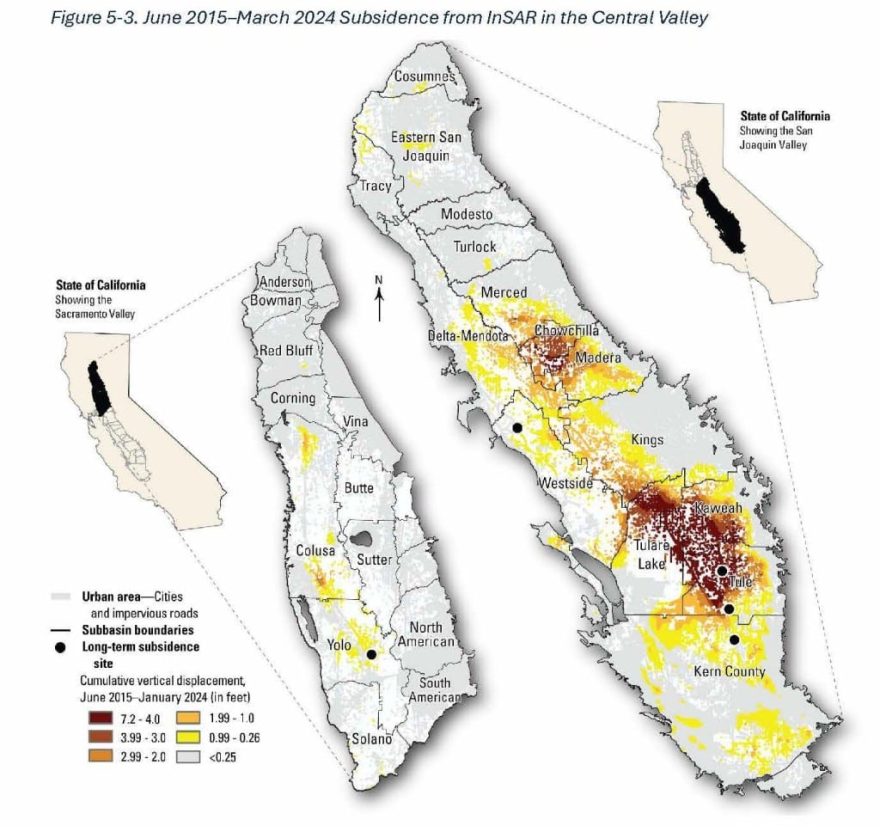This story was originally published by SJV Water.
Newly released state guidelines on how to get a handle on subsidence, or land sinking, were received with mixed reactions after they were released by the Department of Water Resources on Thursday.
The guidelines provide some basic, but pointed, advice on how San Joaquin Valley groundwater managers can best stop, slow or even reverse subsidence, which a 2014 report shows had cost billions of dollars up to that time in history.
Managers should put more water, lots more, into withered aquifers to bring land elevations back up, according to the new guidelines. They should better understand the substrata of their regions in order to predict how over pumping will impact the land. And they should act regionally.
One groundwater agency or water district can’t fix the problem without help from surrounding districts, the new guidelines state.
Yup, was essentially the reaction from Eric R. Quinley, general manager of Delano-Earlimart Irrigation District and Groundwater Sustainability Agency who has been preaching about the need to address subsidence impacts to neighboring districts for years.
“It is unambiguous at this point. I don’t know how you hide from this anymore,” he said of recalcitrant agencies unwilling to rein in excessive pumping.
Even so, others felt the state was acting with more than a touch of hypocrisy to wag a subsidence finger at locals.
Subsidence is nothing new, after all, and was one of the main reasons both the federal and state water systems were built in the 1930s and 1960s, respectively.
The new guidelines themselves note that after the systems began bringing farmers water from the Sacramento-San Joaquin Delta it “…significantly reduced groundwater reliance, initiated groundwater level recoveries, and slowed—and even reversed—subsidence in some areas of the San Joaquin Valley.”
When those systems reduced exports for environmental reasons, farmers began pumping more and subsidence increased.
Now, under the Sustainable Groundwater Management Act (SGMA), the only option is to cut back pumping.
That means less farming, noted Doug Verboon, Kings County Supervisor and board member of Mid-Kings GSA.
“If we don’t have farms providing revenue, we have no income for the programs that support our residents who need them. It’s a simple fix and I think we’re being punished,” he said of what he sees as the need for more water from the delta.
Absent that, water managers are left to sort through limited options.
While the state’s new subsidence guidelines aren’t a mandate, Quinley said they should not be discounted.
“If the suggestions in the (guidelines) are not incorporated, I imagine it gives the state board even more cause to force an interim plan on the Tule subbasin,” he said referring to the Water Resources Control Board, which placed the Tule and Tulare Lake subbasins on probation last year for lacking adequate groundwater plans.

A key issue for both subbasins was runaway subsidence that required a 10-mile section of the Friant-Kern Canal to be rebuilt (and is still sinking) and multiple rebuilds of the Corcoran levee – among other problems.
Probation, under which farmers must meter wells and pay extra fees to the state, is designed to last a year. During that time, Water Board staff and water managers work to hammer out an adequate plan that would protect domestic wells and reduce or stop subsidence.
If they can’t work out a plan, the Water Board can then impose its own pumping restrictions under an interim plan.
Farmers and water managers in the Tule subbasin, which covers the southern half of Tulare County, are just at the start of probation while sanctions in the Tulare Lake subbasin, covering most of Kings County, are on hold pending litigation.
Even so, water managers in both subbasins, along with those in the Kaweah subbasin have been holding regional subsidence meetings, said Mid-Kaweah GSA manager Aaron Fukuda.
“It’s got to be a collective approach. Managing subsidence is keenly difficult if it’s not done by everybody,” he said.
The Kaweah subbasin, which covers the northern half of Tulare County, was once recommended for probation. It turned its fortunes around by presenting a new, much more aggressive groundwater plan that included a robust program to protect domestic wells and was taken off the enforcement track.
The picture is far more fractured in the Tulare Lake subbasin.

Some Tulare Lake groundwater managers have agreed to a joint goal of less than six feet of added subsidence. Meanwhile, one of the region’s largest farming operations and pumpers, the J.G. Boswell Farming Company, is reported to be planning for 10 feet more subsidence, according to multiple presentations by the subbasin’s plan manager.
That won’t work, Fukuda said.
“One grower can solve their issue, but if your neighbor is not going to do it, then we’re all going backwards,” he said.
The state’s new guidelines are clear that subsidence will only be solved regionally.
That’s easier said than done, Verboon said.
“If (the state) can’t control the pumping of five farmers in California, they’re not going to be able to control the 600 in my GSA alone. It’s hard to find a solution with that many personalities.”
FEEDBACK
How to comment
The state is seeking public comments on its subsidence guidelines through Sept. 22, 2025.
Email:
To sgmps@water.ca.gov. Electronic files should be PDF or Microsoft Word compatible.
Mail:
Department of Water Resources
Sustainable Groundwater Management Office
ATTN: Subsidence BMP
P.O. Box 942836 Sacramento, CA 94236-0001

